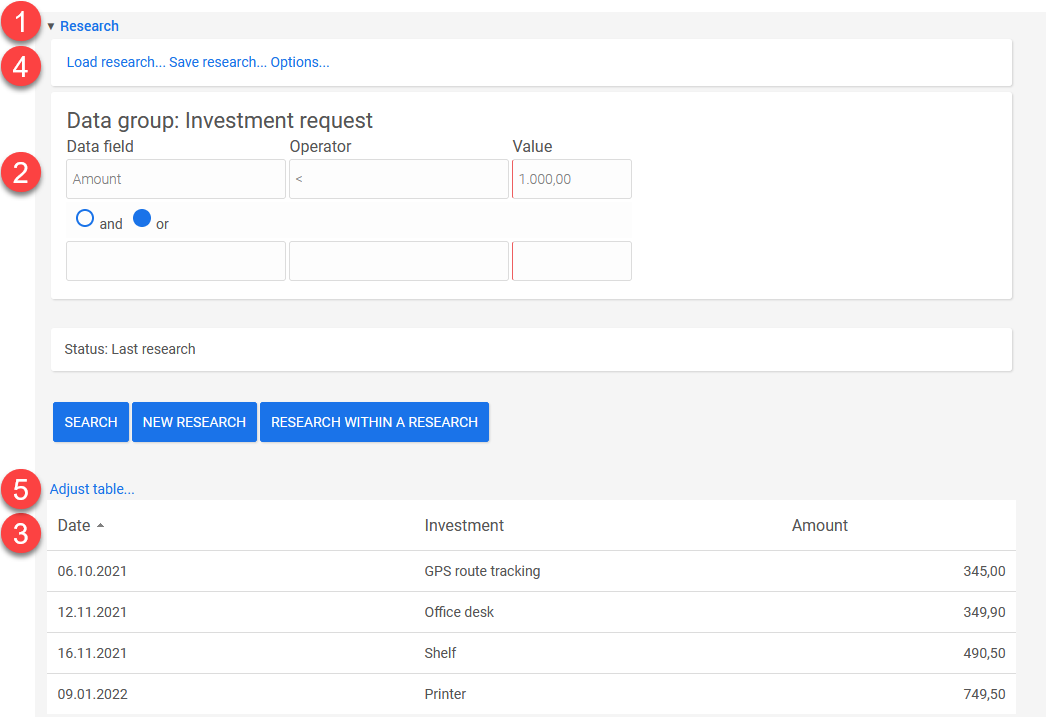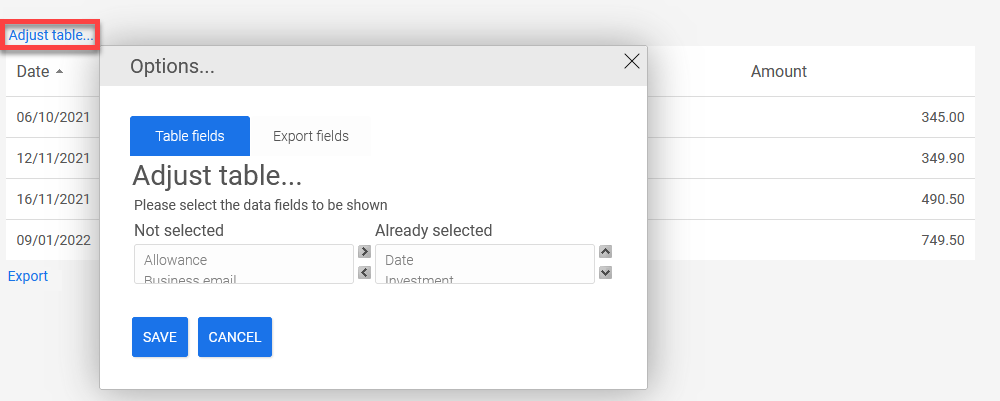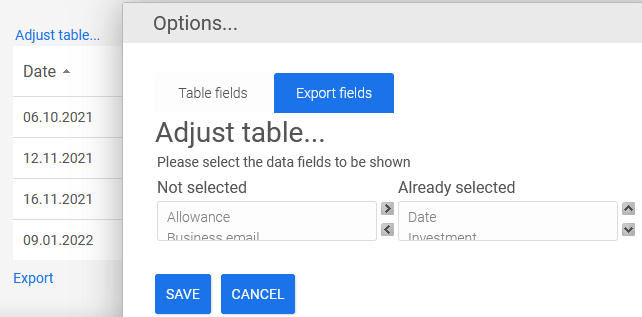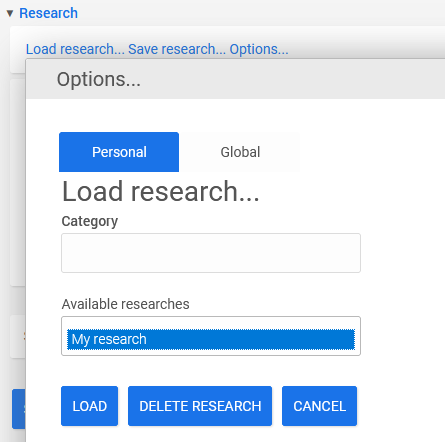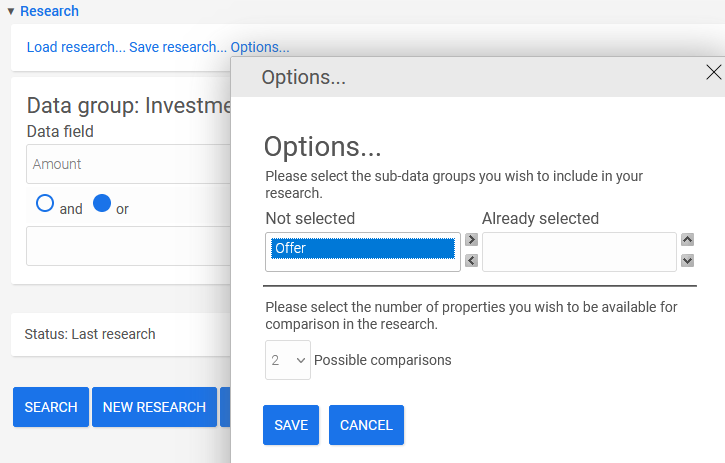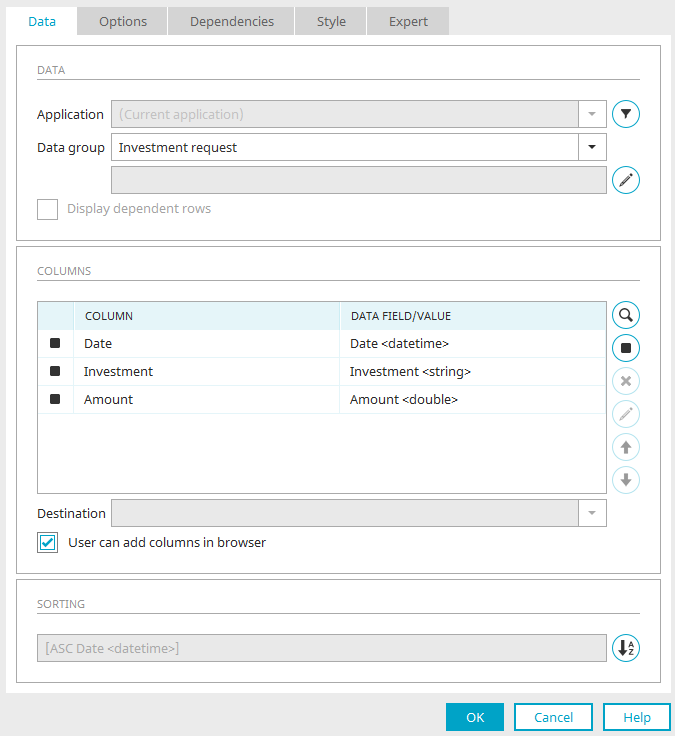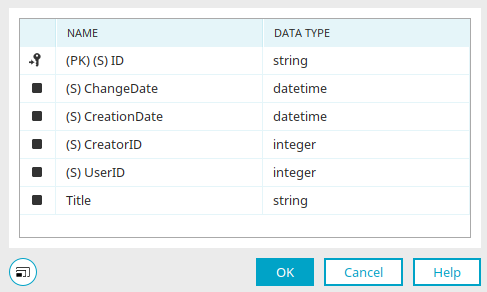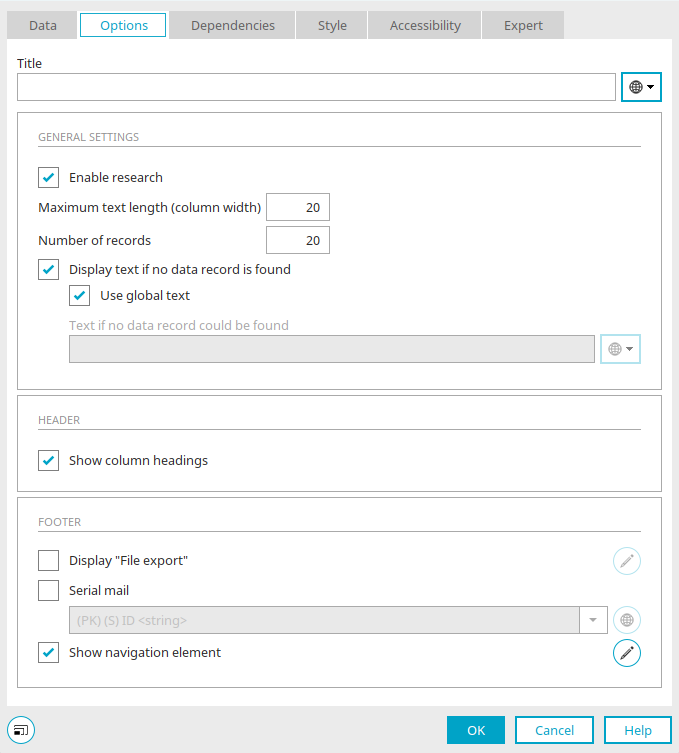Research
With drilldown reporting, complex queries can be executed on the data of an application. Searches that have been run once can be saved and reopened as needed. The columns and the order of the columns in the Results table can be customized by the user.
The application element is part of the "Search and navigation" element category.
The search element can be found in the "Applications" module in the "Elements" section. A new element can be created by dragging and dropping the element from here and positioning it on the workspace.
More information on creating elements can be found here.
The properties dialog of an element opens automatically when a new element is created. The properties dialog of an existing element can be opened by double-clicking the element in the workspace, via the "Properties" context menu, or via the "Edit / Properties" main menu, if the element is selected in the workspace.
Search functions in the browser
1. Link "Research"
Shows or hides the search function. If the search function is hidden, only the results table is visible.
2. Search fields
In this pane, the desired data field, an operator and the value being compared can be selected for the search.
The query can be further extended with an "And" or "Or" link.
Click on Search to perform the search.
A click on "New search" empties the search fields.
Click on "Search within a search" to execute a search based on the results of the first search.
3. Results table
The table in the lower area displays the records to which the executed search applies. By clicking on "Customize table", users can add or remove columns and also change the order of the fields, if this was allowed in the search configuration.
On the "Export Fields" tab, you can decide which table columns should be included in the export of the table data. You can learn how to export the Results table here.
In the properties dialog of the search, the "Serial mail" setting can be activated on the "Data" tab. Then you will find the "Email" link below the table. The function can only be used if a data field containing emails is included as a column in the Results table.
The email can be sent in text or HTML format. Also enter the sender, subject and text of the email.
Recipient email
The data field that contains the email addresses can be selected here.
Insert auto-fields
The field selected here will be implemented in the text field of the email as a placeholder, consisting of the data field name and the GUID of the field. In the email, the value of the field will be inserted later instead of the placeholder.
Send
By clicking on "Send", an email is sent to every email address in the Search results. Click on "Preview" to view the email in another window. By clicking on "Test email", an email address of your choice can be entered in the new window. A test email with the defined content will be sent to this address.
4. Load search / Save search / Options
If you have executed a search and want to execute it again in the future, click on the "Save search" link.
Use the tabs "Personal" and "Global" to decide whether the search should be accessible for you personally only or also for other users. Searches can be saved under categories for easy reference. Give the search a name. Under "Existing searches", a search can be selected to be overwritten with the new, current settings.
"Save field settings with search" saves the field selection and opens it when the current search is reopened later. In the same way, the field settings for the export of the search can be transferred.
By clicking on the "Load search" link, the saved search can be opened and used again later. An existing search can be opened here.
Clicking on the "Options" link displays a page where subordinate data groups can be selected, to which the search will then also be applied. The search criteria (data field, operator and field) can also be increased here.
Configuration
The search can be configured in the Properties dialog.
Data
Select the application and data group whose data is to be searched here.
![]() Filter
Filter
Opens a dialog where the filter expressions can be defined.
![]() Add subordinate data group
Add subordinate data group
Opens a dialog where you can select which subordinate data groups should also be included in the search.
Subordinate data group
Select the desired data group here and then click on "OK". This saves the changes and closes the dialog again.
Display dependent rows
Only data records that are in a parent-child relationship to the superior, currently selected data record will be shown.
Columns
All the titles of the data fields that are integrated as table columns are listed here. Under "Data field/Value" you will find the data type of the respective integrated data fields.
![]() Button
Button
This menu item allows any number of buttons to be added to each table row. Each button is displayed in its own table column and can open a page where the data are displayed in detail. You can select the desired page in the "Jump target" selection list.
![]() Data field
Data field
Opens a diealog in which the desired data fields can be selected and added as a table column.
Select column
The name and data type of the data fields that can be included as a table column are displayed here. Simply select the desired field. Multiple fields can be selected by clicking on them while holding down the CTRL key.
Click "OK" to save the changes and close the dialog again.
![]() Remove column
Remove column
Deletes the selected table column from the list.
![]() Edit container
Edit container
Depending on which column is currently selected (button, data field, calculation or static text), the corresponding properties dialog will be opened in which you can find the further settings.
You can find further help there by clicking on "Help" at the bottom right of the dialog or by pressing the F1 key.
![]()
![]()
With the arrow buttons, the order of the columns can be changed as desired. The higher a field is positioned in the list, the further left the column will be shown in the table.
Users can add columns in the browser
Authorizes users to add or remove columns in the search results table. If the setting is selected, the "Adjust table" link will be shown above the results table in the browser.
![]() Sorting
Sorting
Opens a dialog where the table's sorting can be defined.
Options
Title
Enter the title for the search here. Click here for information on multilingual titles.
General settings
Enable search
Displays the search function in the browser or hides it, respectively. If the search function is hidden, only the results table is shown.
Maximum text length (column width)
Presets the maximum amount of characters that should be shown for each data record in the column.
Number of records
Defines the maximum number of data records that should be shown on a page in the browser. If -1 is entered here, all records will be displayed.
Display text if no data record is found
If this is selected, a text will be displayed when there is no data available.
-
Use global text
With this setting, the text used will be the one stored in the language constant "DR_NO_RECORD", it will also be displayed multilingually according to the regional settings of the portal properties.
-
Text if no data record is found
If the setting "Use global text" is not activated, a static text can be entered in the entry field below or you can select a language constant that will provide the text.
Header
Show column headings
Displays the column headings.
Footer
Display "File export"
All information on this topic can be found here.
Serial mail
Displays the "Email" button link beneath the results table. The setting can only be used if a data field containing email addresses is included as a column.
Navigation element
All information on this topic can be found here.
